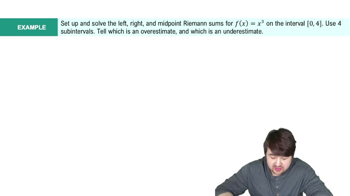Identifying Riemann sums Fill in the blanks with an interval and a value of n.
4
∑ ƒ (1 + k) • 1 is a right Riemann sum for f on the interval [ ___ , ___ ] with
k = 1
n = ________ .
 Verified step by step guidance
Verified step by step guidance Verified video answer for a similar problem:
Verified video answer for a similar problem:

